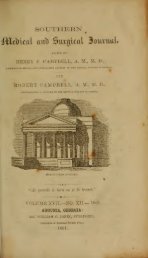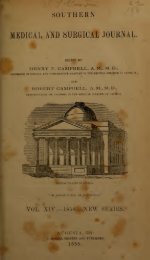:1849.] Ampvican <strong>Medical</strong> Associaiinv. fH''Though a disapjre^ble sense of suffocation <strong>and</strong> choking iscaused by the operation, the patient soon recovers from it, <strong>and</strong>submits to a repetition after a short interval. In every instancethe operation has been performed twice, <strong>and</strong> in some threetimes."Before proceeding to the operation, it has always been explainedto the patient, that the seat of his difficulty was a swellingat the top of the windpipe, preventing the air from entering,<strong>and</strong> the object of the operation was to cut it <strong>and</strong> let outfluid, <strong>and</strong> thus give him relief This explanation corresponds60 exactly with his own sensations, which refer to the top of thethyroid cartilage as the seat of obstruction, that he readily submitsto the proposed operation, <strong>and</strong> renders all the co-operationin his power for its performance,*'A slight hemorrhage follows the scarifications, <strong>and</strong> shouldbe encouraged by gargling with warm water. In one instancethe quantity of blood mixed with sputa amounted to half a wineglassful."The first case for employing the operation was the following"Case I. Arthur W. Taylor, seaman, born in New York,aged thirty-one years, was acting as nurse in Ward No. 4,south building, New York Hospital. For two days previousto the 13th of April, 1847, when his case was first noticed hehad suffered from painful deglutition, with elongation of theuvula, that kept up a constant tickling sensation—the faucesalso presented an inflamed appearance. The epiglottis wasseen as well as felt to be swollen. Breathing was difficult, <strong>and</strong>attended with paroxysms of suffi:>cation.."A stimulating gargle had been used, <strong>and</strong>, on the morning ofthe above date, the uvula had been excised with some rehefSix leeches had been applied over the larynx, <strong>and</strong> the bites werestill bleeding at the time of the regular visit at noon. Afterexploring the parts with the finger, <strong>and</strong> ascertaining the existenceof swelling of the epiglottis, <strong>and</strong> also allowing my twoassistants to do the same, I scarified the aryteno-epiglottic folds<strong>and</strong> the epiglottis, partly with scissors curved flatwise, <strong>and</strong> partlywith a sharp pointed curved bistoury, guarded to within onethirdof an inch of its point by a narrow strip of adhesiveplaster wound around it, <strong>and</strong> conducted to the parts upon thefore-finger of the left h<strong>and</strong>, previously introduced at the rightangle of the mouth. Two or three repetitions were requisite,at short intervals, to complete the operation. The patienthawked up three or four tea-spoonsful of blood, mixed withmucus, <strong>and</strong> expressed himself as feeling relieved. Twenty
American <strong>Medical</strong> Association.'[J antMfy,ounces of blood were drawn from the arnm soon after, <strong>and</strong> graindoses of tartar emetic administered.*'0n the following day (the 14th), an improvement in^the respirationhad evidently taken place."On the 15th, respiration was stillwas 84, <strong>and</strong> soft ;patient complained of soreness of the scarrifiedparts. Antimony was stopped."On the 17th he was much improved in all respects, pulse 68.*'0n the 23d he was discharged cured.further improved, the pulse*' The question of diagnosis in this disease is one of vital importance,irrespective of the present operation, but in connectionwith it its importance becomes very greatly enhanced. Withoutstopping to notice the distinctive symptoms which havebeen generally regarded as characteristic of this disease, orthose- of other diseases that are most likely to be mistaken forit, I beg leave to insist upon one sign which is strictly pathognomonic,<strong>and</strong> does not appear to have been sufficiently appreciated."I refer to the swelling of the epiglottis as ascertained by thetouch. The disc6very of it, according to Bayle, Die. des Scien.Med., tome xviii., p. 507,) is due to M. Thuillier, who proposedit in a thesis sustained before the Faculty of Medicine in Paris,in 1815. The value of this sign will be admitted if we considerhow frequent the swelling of the epiglottis co-exists wnththat of the glottis. Bayle, {lac. cit.) who dissected more thanseventeen cases of this disease, says, 'the epiglottis is rarelyintact, often it is very much swollen at its edges.' Ryl<strong>and</strong> says,{he. cit., p. 48,) 'The oedema is seldom confined to theselocalities, but extends to the base <strong>and</strong> lateral edges of theepiglottis, &c.'" Among seventeen cases collected from different sources^<strong>and</strong> in which the condition of the epiglottis was ascertained,either by dissection after death, or by the touch or inspectionduring life, swelling was found in fifteen. Of the eight casesreported in this paper, the epiglottis was found swollen in seven,<strong>and</strong> in the remaininir one there was no evidence that it was notswollen."This swelling takes place either at the margin on one orboth sides of the median line, or on the lingual surface of theepiglottis at its base, filling up one or both depressions betweenit <strong>and</strong> the tongue, <strong>and</strong> obliterating the central glosso-epiglotticfraenum.'*It conveys to the touch the sensation of a soft pulpy body,easily recognized <strong>and</strong> distinguished from the stifi' rigid swellingof these parts in membranous laryngitis."The facility of ascertaining the condition of the epiglottis
- Page 1 and 2: SOUTHERNMEDICAL AND SURGICAL JOURNA
- Page 3 and 4: 2 O'KeefCe, on the Properties of Do
- Page 5 and 6: 4 O'Keeffe, on the Properties of Do
- Page 7 and 8: 6 O'Keeffe, on the Properties of Do
- Page 9 and 10: y—8 O'Keefie, on the Properties o
- Page 11 and 12: 10 0'Keeffe,onthePrope7*tiesofDogtt
- Page 13 and 14: ;12 O'Keeffe, on the Properties of
- Page 15 and 16: ;14 O^Keeffe Jon the Properties of
- Page 17 and 18: ;:1 6 O'Keeffe, on the Proper^ties
- Page 19 and 20: 18 O^Keeffe, on the Properties of D
- Page 21 and 22: :60 O'KeefFe, on the Properties of
- Page 23 and 24: 22 O'Keeffe^ on the Properties ofDo
- Page 25 and 26: —24 O'Keeffe, on the Properties o
- Page 27 and 28: —26 O'Keeffe, on the Properties o
- Page 29 and 30: 28 O^Keeffey on the Properties of D
- Page 31 and 32: 30 Eve, on Clinical Surgery. [Janua
- Page 33 and 34: —American Medical Association.[Ja
- Page 35 and 36: American Medical Association.\)^rm.
- Page 37 and 38: —36 American Medical Association.
- Page 39: 38 American Medical Association. [J
- Page 43 and 44: ^ New Operation for Cure of Varicoc
- Page 45 and 46: 4^ Cases of Pneumonia Typhoides. [J
- Page 47 and 48: 46 Cases of Pneumonia Typhoides. [J
- Page 49 and 50: —Scrofula— its causes,[January,
- Page 51 and 52: 50 Treatment of Ganglion. [January,
- Page 53 and 54: —52 Monthfy Periscope. [January,f
- Page 55 and 56: ——54 Monthly Periscope. [Januar
- Page 57 and 58: ———56 Monthly Periscope. [Jan
- Page 59 and 60: —58 Monthly Periscope. [January,R
- Page 61 and 62: ——so Monthly Periscope. [Januar
- Page 63 and 64: §2 Monthly Periscope.— Medical I
- Page 65: ; 1164 Medical Intelligence. -Meteo








